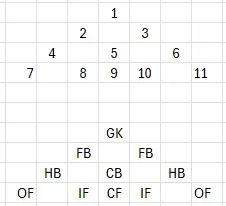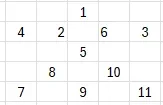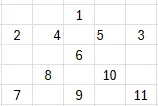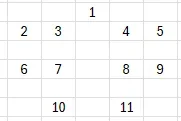CrookesBlade
Well-Known Member
The “Number 6” thing baffles me.4/8 if you’re truly non woke!
Number 6 is a centre half!!!! Always has been. Can’t think of any deep lying midfielder who wore number 6 in the days when numbers meant something.
Follow along with the video below to see how to install our site as a web app on your home screen.
Note: This feature may not be available in some browsers.
All advertisments are hidden for logged in members, why not log in/register?
The “Number 6” thing baffles me.4/8 if you’re truly non woke!
The “Number 6” thing baffles me.
Number 6 is a centre half!!!! Always has been. Can’t think of any deep lying midfielder who wore number 6 in the days when numbers meant something.
Only from my distant days Duncan Edwards and Dave Mackay but yes, I've always seen 4 as the midfield number.The “Number 6” thing baffles me.
Number 6 is a centre half!!!! Always has been. Can’t think of any deep lying midfielder who wore number 6 in the days when numbers meant something.
Wasn’t 6 the left half and 4 the right half ?The “Number 6” thing baffles me.
Number 6 is a centre half!!!! Always has been. Can’t think of any deep lying midfielder who wore number 6 in the days when numbers meant something.
Everton in the 80s had Peter Reid in the no. 6 shirt, as their CB captain, Ratcliffe wore no. 4.The “Number 6” thing baffles me.
Number 6 is a centre half!!!! Always has been. Can’t think of any deep lying midfielder who wore number 6 in the days when numbers meant something.
HodgkinsonWasn’t 6 the left half and 4 the right half ?
5 was the centre half in between fullbacks 2and3.
(I typed Coldwell but for some stupid reason the autocorrect changed it to Caldwell FFS)Hodgkinson
Caldwell-G Shaw
Richardson-J Shaw-Summers
The most perfect example of this classic formation.
Trevor Hockey played at 6 in midfield for us and John Flynn at 4 in defence.The “Number 6” thing baffles me.
Number 6 is a centre half!!!! Always has been. Can’t think of any deep lying midfielder who wore number 6 in the days when numbers meant something.
Spot on .Hodgkinson
Caldwell-G Shaw
Richardson-J Shaw-Summers
The most perfect example of this classic formation.
The “Number 6” thing baffles me.
Number 6 is a centre half!!!! Always has been. Can’t think of any deep lying midfielder who wore number 6 in the days when numbers meant something.





This is, without doubt, one of the best posts I've ever read on this forum. I was always a little confused by this and its answered all my questions. Brilliant.Not quite. Depends where in the world you are.
It all stems from the evolution from 2-3-5. In that formation, it was quite straightforward in terms of numbers. 2 and 3 were full backs; 4 & 6 half backs; 5 centre back; 7 & 11 outside forwards, 8 & 10 inside forwards & 9 centre forward:
View attachment 219846
Different countries modified this when the changes in the offside law meant that more players needed to be in defence. In the UK, we moved the centre half and the left half back into the middle of the defensive line and the 7, 8 & 11 to join the 4 in a midfield four, leaving 9 & 10 as forwards:
View attachment 219847
In South America, however, things were different. Not only was 4-3-3 preferred but they'd moved different roles. 5 stayed as the central defensive midfielder in both Brazil and Argentina but the two defensive numbering systems were different:
Brazil:
View attachment 219848
Argentina:
View attachment 219849
In Spain (and a lot of Europe), it was different again with 2-4-5-3 being the defence and 6-8-10 being the midfield - hence those numbers now being used to describe a midfielder's role in the team:
View attachment 219850
Modern cases in point:
Javier Zanetti wearing 4 at RB for Argentina, Roberto Carlos wearing 6 at LB for Brazil with Lucío wearing 3 at CB. Xavi wearing 6 for Barcelona and Spain.
Needs Beattie up front
Happy to helpThis is, without doubt, one of the best posts I've ever read on this forum. I was always a little confused by this and its answered all my questions. Brilliant.
Not quite. Depends where in the world you are.
It all stems from the evolution from 2-3-5. In that formation, it was quite straightforward in terms of numbers. 2 and 3 were full backs; 4 & 6 half backs; 5 centre back; 7 & 11 outside forwards, 8 & 10 inside forwards & 9 centre forward:
View attachment 219852
Different countries modified this when the changes in the offside law meant that more players needed to be in defence. In the UK, we moved the centre half and the left half back into the middle of the defensive line and the 7, 8 & 11 to join the 4 in a midfield four, leaving 9 & 10 as forwards:
View attachment 219847
In South America, however, things were different. Not only was 4-3-3 preferred but they'd moved different roles. 5 stayed as the central defensive midfielder in both Brazil and Argentina but the two defensive numbering systems were different:
Brazil:
View attachment 219848
Argentina:
View attachment 219849
In Spain (and a lot of Europe), it was different again with 2-4-5-3 being the defence and 6-8-10 being the midfield - hence those numbers now being used to describe a midfielder's role in the team:
View attachment 219850
Modern cases in point:
Javier Zanetti wearing 4 at RB for Argentina, Roberto Carlos wearing 6 at LB for Brazil with Lucío wearing 3 at CB. Xavi wearing 6 for Barcelona and Spain.

Not quite. Depends where in the world you are.
It all stems from the evolution from 2-3-5. In that formation, it was quite straightforward in terms of numbers. 2 and 3 were full backs; 4 & 6 half backs; 5 centre back; 7 & 11 outside forwards, 8 & 10 inside forwards & 9 centre forward:
View attachment 219852
Different countries modified this when the changes in the offside law meant that more players needed to be in defence. In the UK, we moved the centre half and the left half back into the middle of the defensive line and the 7, 8 & 11 to join the 4 in a midfield four, leaving 9 & 10 as forwards:
View attachment 219847
In South America, however, things were different. Not only was 4-3-3 preferred but they'd moved different roles. 5 stayed as the central defensive midfielder in both Brazil and Argentina but the two defensive numbering systems were different:
Brazil:
View attachment 219848
Argentina:
View attachment 219849
In Spain (and a lot of Europe), it was different again with 2-4-5-3 being the defence and 6-8-10 being the midfield - hence those numbers now being used to describe a midfielder's role in the team:
View attachment 219850
Modern cases in point:
Javier Zanetti wearing 4 at RB for Argentina, Roberto Carlos wearing 6 at LB for Brazil with Lucío wearing 3 at CB. Xavi wearing 6 for Barcelona and Spain.
Where’s Beatts?
Liverpool always had centre backs as 4 and 6. Number 5 used to be left side midfield. Ray Kennedy or Ronnie Whelan spring to mind.Even in England some clubs chose to move back the right half back, ie number 4, and not the number 6. I think this happened more often if the club didn't have a left footed, defensively good number 6.
Unaware of the above I remember being confused as to why Man Utd had Steve Bruce wearing number 4 and Gary Pallister number 5 in the 90s. Was that always a Man Utd tradition?
And 7 for EnglandI'll point out currie was 10 for us 4 for England playing in the same position ,it's just a number on your back
Was the same in Norway.The Swedes go right to left too don't they?
So in a 4-4-2:
View attachment 219858
Ljungberg always wore #9 on the left.
He's got the fluNeeds Beattie up front
And 6And 7 for England
Best and Law wore 7-11 inclusive during their time at Old Trafford. Law even wore #4 once apparently. Bobby Charlton wore them all but 7. All three wore 12 when subs came in, err as they were subs……Even in England some clubs chose to move back the right half back, ie number 4, and not the number 6. I think this happened more often if the club didn't have a left footed, defensively good number 6.
Unaware of the above I remember being confused as to why Man Utd had Steve Bruce wearing number 4 and Gary Pallister number 5 in the 90s. Was that always a Man Utd tradition?
I think Pallister wore 6 and midfielders/ wingers such as Lee Sharpe wore 5Even in England some clubs chose to move back the right half back, ie number 4, and not the number 6. I think this happened more often if the club didn't have a left footed, defensively good number 6.
Unaware of the above I remember being confused as to why Man Utd had Steve Bruce wearing number 4 and Gary Pallister number 5 in the 90s. Was that always a Man Utd tradition?
Just printed this out for the wife. She loves a sudoku puzzle.Not quite. Depends where in the world you are.
It all stems from the evolution from 2-3-5. In that formation, it was quite straightforward in terms of numbers. 2 and 3 were full backs; 4 & 6 half backs; 5 centre back; 7 & 11 outside forwards, 8 & 10 inside forwards & 9 centre forward:
View attachment 219852
Different countries modified this when the changes in the offside law meant that more players needed to be in defence. In the UK, we moved the centre half and the left half back into the middle of the defensive line and the 7, 8 & 11 to join the 4 in a midfield four, leaving 9 & 10 as forwards:
View attachment 219847
In South America, however, things were different. Not only was 4-3-3 preferred but they'd moved different roles. 5 stayed as the central defensive midfielder in both Brazil and Argentina but the two defensive numbering systems were different:
Brazil:
View attachment 219848
Argentina:
View attachment 219849
In Spain (and a lot of Europe), it was different again with 2-4-5-3 being the defence and 6-8-10 being the midfield - hence those numbers now being used to describe a midfielder's role in the team:
View attachment 219850
Modern cases in point:
Javier Zanetti wearing 4 at RB for Argentina, Roberto Carlos wearing 6 at LB for Brazil with Lucío wearing 3 at CB. Xavi wearing 6 for Barcelona and Spain.
All advertisments are hidden for logged in members, why not log in/register?
